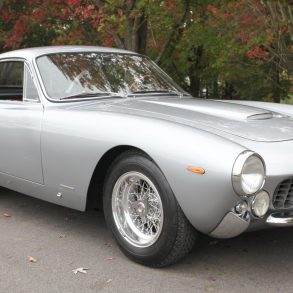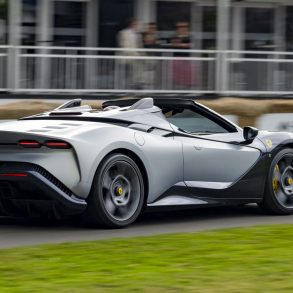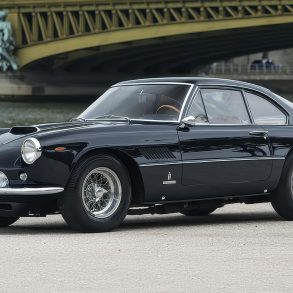Bell Sport & Classic proudly announced the ultimate example of their expertise in outstanding in-house restoration with the authentic remastering of one of the rarest period Ferrari racing cars ever made, the 330 LMB.
The vision was to create the perfect, remastered 330 LMB. To achieve an authentic 330 LMB, they aimed to blend originality with the latest restoration techniques and sympathetic enhancements.
This one-off car was constructed to be used and enjoyed on the road. Based on a Ferrari 330 GT 2+2, it delivers recognition to the original 330 LMB (only four units were made in the period for competition purposes). The example has a bespoke alloy body hand-crafted using templates from Chassis 47250 – the only right-hand-drive example ever produced.
All the components employed were either period-correct or created by the Bell Sport & Classic’s expert team. The 330 LMB Project is the embodiment of the company’s skills and expertise, raising the bar to new levels of finish for Bell Sport & Classic restorations.

Rarer than the Ferrari 250 GTO
The Ferrari 330 LMB (Le Mans Berlinetta) was developed by Mike Parkes, a British-born Ferrari racing driver and engineer, to challenge at the 1963 Le Mans 24 Hours. His brainchild was based on the Ferrari 250 GTO but was fitted with a more powerful 390bhp, 4.0-liter, Colombo V-12 engine. It was also displayed a wheelbase that was 20mm longer and redesigned aluminum body.

Only four 330 LMB were ever constructed, three being left-hand drive and only one right-hand drive, making the profoundly significant 330 LMB even rarer than the 250 GTO with Ferrari producing near 10 times as many.
Three of the 330 LMBs were used to compete at the 1963 24 Hours of Le Mans. Only the example that Colonel Ronnie Hoare’s British Maranello Concessionaires Ltd team entered completed the race with Mike Salmon and Jack Sears taking the fifth position.
During this period of time, Ferrari was about to transition to mid-engined configuration competition cars, making the 330 LMB to become the last Maranello front-engined race car.
Unfinished Vision
The remastering project was a dream that took more than ten years in the making. Bell Sport & Classic Managing Director Tim Kearns shared:
“The story begins with Edward Carter, an Essex farmer who was a huge Ferrari enthusiast. Ed wanted to add a 250 GTO recreation to his collection but was steered away by one of the pre-eminent 330 LMB experts, Terry Hoyle. Having intimate knowledge of Chassis 4725, the original right-hand-drive LMB, Terry had another idea: ‘There are many 250 GTO recreations – you should do an LMB instead’.”

In November 2010, Ed purchased a donor right-hand-drive 1964 Ferrari 330 GT 2+2, and a vision unfolded; to make a more road-worthy recreation but maintaining its racer’s character.
RS Panels skills were acquired to shorten the chassis and to build a bodywork buck. Along with the extensive set of photos of Chassis 4725, they took a trip to New York to measure and take more pictures of the original 4725 car. Unfortunately, tragedy struck, as Ed Carter had a road accident and lost his life in September 2015. For the next two years, the car was left dormant.

Bell Sport & Classic Enters the Picture
In 2017, the owner of Bell Sport & Classic entered the picture where they set an all-encompassing goal of using the project as a test case for Bell Sport & Classic restoration skills to establish a new industry benchmark.
Bell Sport & Classic’s core business is restoring period Ferrari, Aston Martin, and Lamborghini, so they saw the 330 LMB project as a great opportunity. Most importantly, to complete one man’s vision of building what is arguably the only 330 LMB remastering in the world, but to also be able to enhance it, creating a truly unique one-of-one road car that is a perfect mix of authenticity, originality, utilizing the very latest restoration techniques.

Having more than sixty years of collective knowledge and experience on the Ferrari marque, the team at Bell Sport & Classic was the best team to take on the enormous amount of work that was compelled to complete the project with the highest possible standards.
Elliot East was project Head, having restored classic cars, especially classic Ferraris, since the early 2000s. Attilio Romano, a former Ferrari factory technical team member in Maranello, who also led HR Owen’s Ferrari technical department for 22 years, now leads Bell Sport & Classic’s engineering department.
Building the Body
The wings and roof of the car were already attached when it reached Bell Sport & Classic, but the door skins were incomplete, and the dashboard was not fitted.
As they were, the doors were spot-on for an original LMB. They felt super-light, but they lacked the more substantial road car weight we were looking for. So, we reworked them repeatedly, but very subtly, strengthening every aspect, including the hinges, the skins, and the window frames, until we got a perfect weight.

A lot of parts needing to complete the body could not be sourced anywhere in the world, at least not of the high quality that Bell Sport & Classic needed. So, they resorted to creating them in-house.

We spent more than a year searching for window catches; in the end, we made them ourselves to ensure we were happy with the fit and finish. Our engineering department also made the aluminum fuel filler cap from scratch.”
In respect to the bodywork, Bell Sport & Classic team fabricated numerous items, included the straps and the bonnet’s finishers. The off-the-shelf Lusso windscreen fitted perfectly on the front of the vehicle, but they had to create the rear Perspex screen in-house.


They repeated the process for the headlamp covers. The team initially had to cut the aluminum to shape, which they then used to develop a former, from which they fashioned the perfectly finished Perspex items.
The Vehicle was subjected to a complete ‘dry build’ The process had the team fitting all the trim pieces such as the windscreen surrounds and glass and door handles to the bare metal body to make sure that the components fit perfectly after the car returned from the paint shop.

After it reached a level of quality that the team was happy with, the body was then given a classic Rosso Corsa red finish that took a ten-week period to finish. They subsequently added white racing roundels as the Maranello factory at the time would have added them before the challenge at Le Mans back in 1963. They also hand-painted Scuderia Ferrari emblems on each front wing.

The 330 LMB’s Heart and Soul
To give the Colombo V-12 engine the full LMB specification, the engineering department converted it to dry-sump specification and increased the capacity to 3967cc from 2953cc.

“An extraordinary level of work was required to complete the process. Items such as the camshafts, timing case, water pump, oil and fuel tanks, oil filler tubes, and caps had to be specially created for the car.”
Attilio Romano
Instead of the Weber 42s that were fitted to the engine in the period, the six carburetors are bespoke commissions. After the fully rebuilt engine was complete, it was run-in and tuned on the dyno, with the result being 390bhp at 7000rpm and 300 lb/ft of torque at 6000rpm, which was exactly the amounts it had in period. The only specification modification they did was to add a cooling fan, showing the car’s road bias.


When the project started, they had already sourced a five-speed transmission from an Mk2 330GT from Switzerland. All the original race cars had four-speed gearboxes, but Bell Sport & Classic kept the five-speed unit as a sympathetic enhancement to increase the car’s road manners and useability.
The transmission was completely rebuilt, employing specially-manufactured selector forks and providing all new synchros and hubs. They stripped down the entire suspension system and had it fully refurbished. The configuration had upper and lower wishbones with coil springs and telescopic dampers at the front.

At the rear, they had a more road-focused set-up with a five-bar linkage with leaf springs and a coil-over ‘helper’ damper instead of the Watts linkage and Panhard rod that the period competition car had. A completely rebuilt limited-slip differential completed the set-up.
Competition Lusso Interior
Given the original 330 LMBs were designed to race at Le Mans, comfort was not at the top of the list. They had functional cabins that were bare-painted in silver Hammerite, complete with a wrinkle finish dashboard and black Corduroy seats.


In line with Ed Carter’s vision of creating a ‘GT version’ of the 330 LMB, the Bell Sport & Classic team worked hard to create a correct, authentic interior but offers more comfort for road use.
The aluminum gear level turret of the car, which features the classic open-gate and tall gear lever, is exactly as it would have looked when it left Maranello back in 1963. Like many of the other components of the car, however, the gorgeous cabin centerpiece was made completely from scratch, in-house.

Sympathetic upgrades done on the example include an electronic ignition, high torque starter motor, electric fuel pumps, and an electric cooling fan. The 330 LMB was also given a hidden modern voltage regulator, electric washer motor, full fire system, and a welded, leak-free fuel tank in an external riveted tank.

“This remarkable 330 LMB remastering is an outstanding showcase for the incredible talent that lies within Bell Sport & Classic. The dedication they have put into this very special project over the last three years is outstanding, with every component either restored, rebuilt, or created from scratch, blending the very latest restoration and engineering techniques with a selection of sympathetic upgrades.”
Managing Director of Bell Sport & Classic Tim Kearns.

[Source: Bell Sport & Classic]











STUNNING
KEN
AUSTRALIA
Does anyone know who owns Chassis 4725-I have compiled a list of all original 250GTOs and 3 x 330LMBs but was unaware of 4725(GT)
Very beautiful car, one of the most beautiful race cars in history, and wonderful restoration work. Congratulations to the team.
Outstanding workmanship and the finish product is absolutely fantastic.